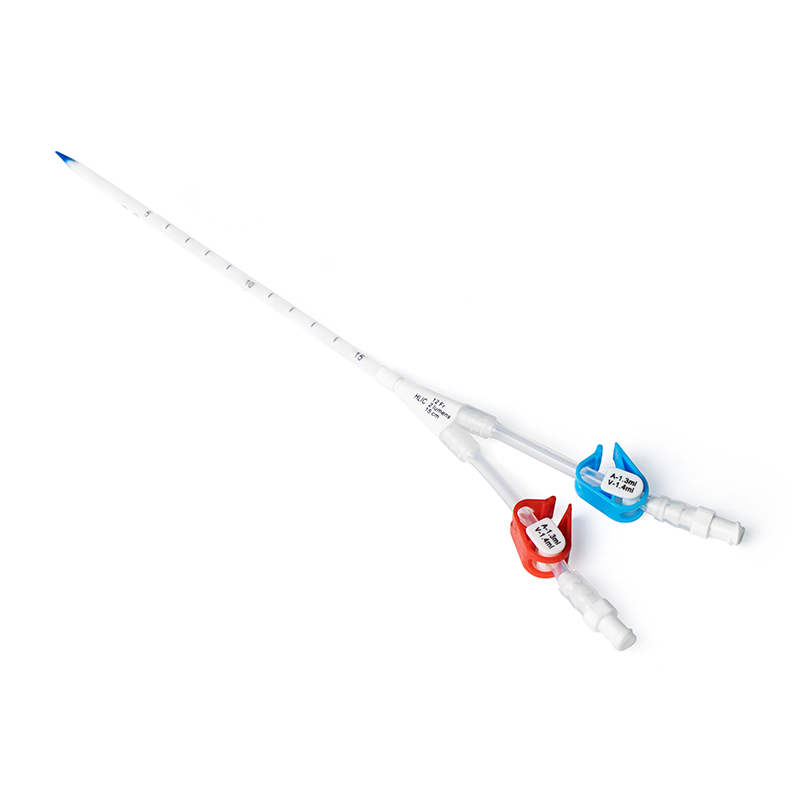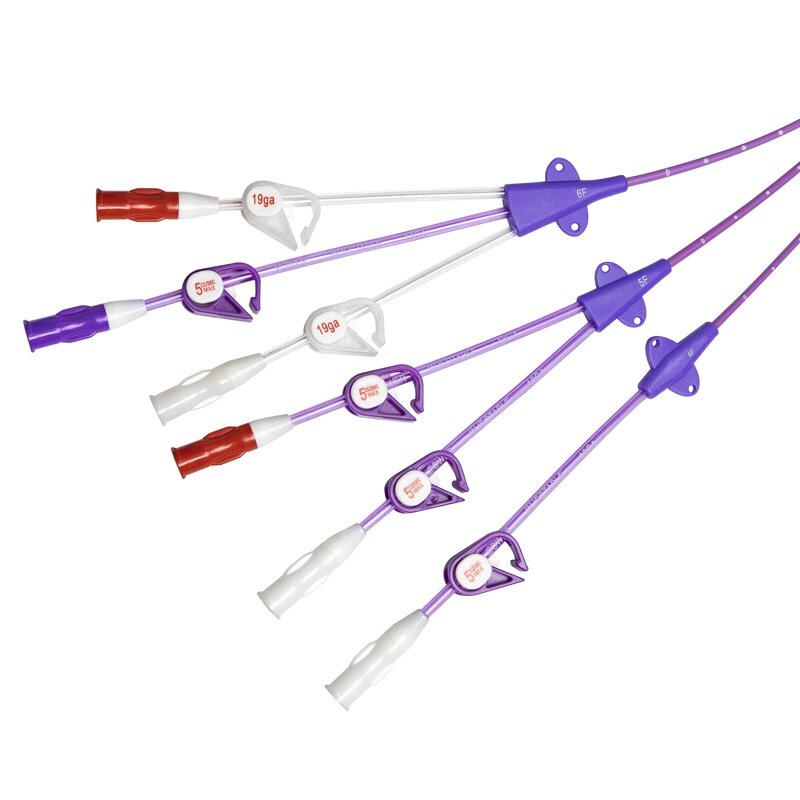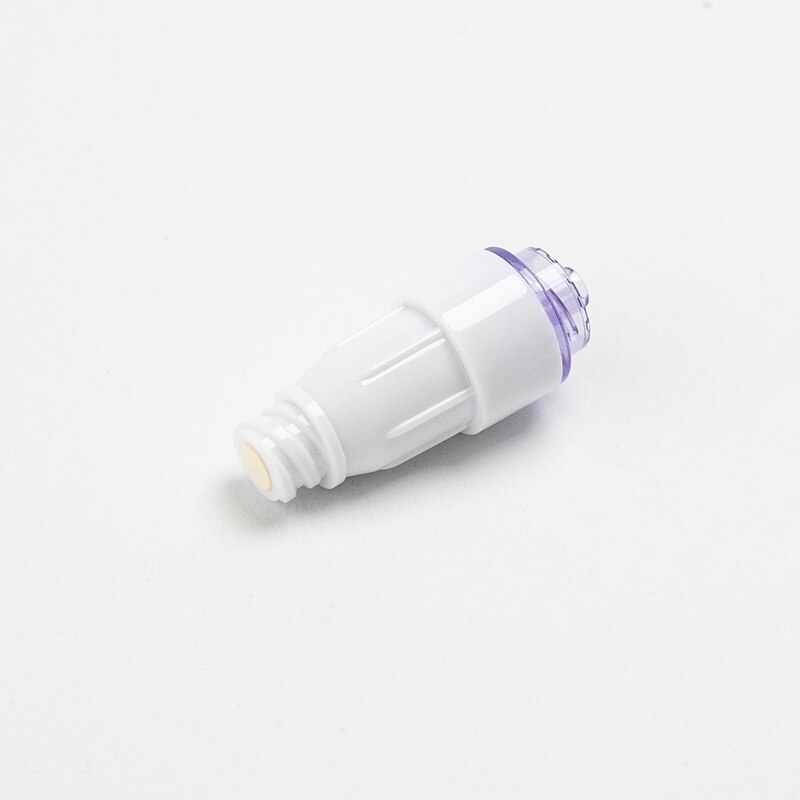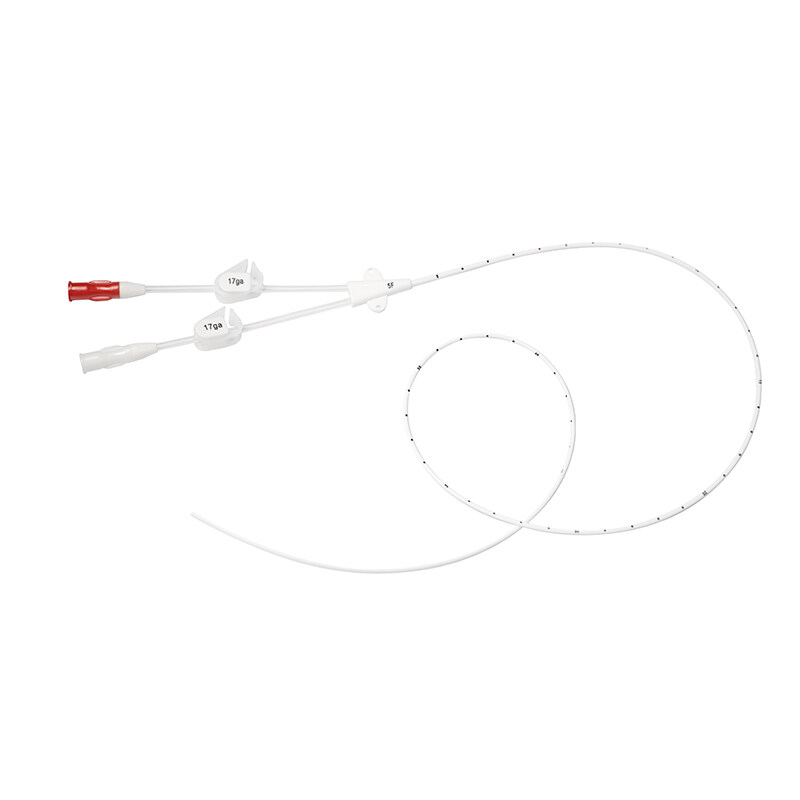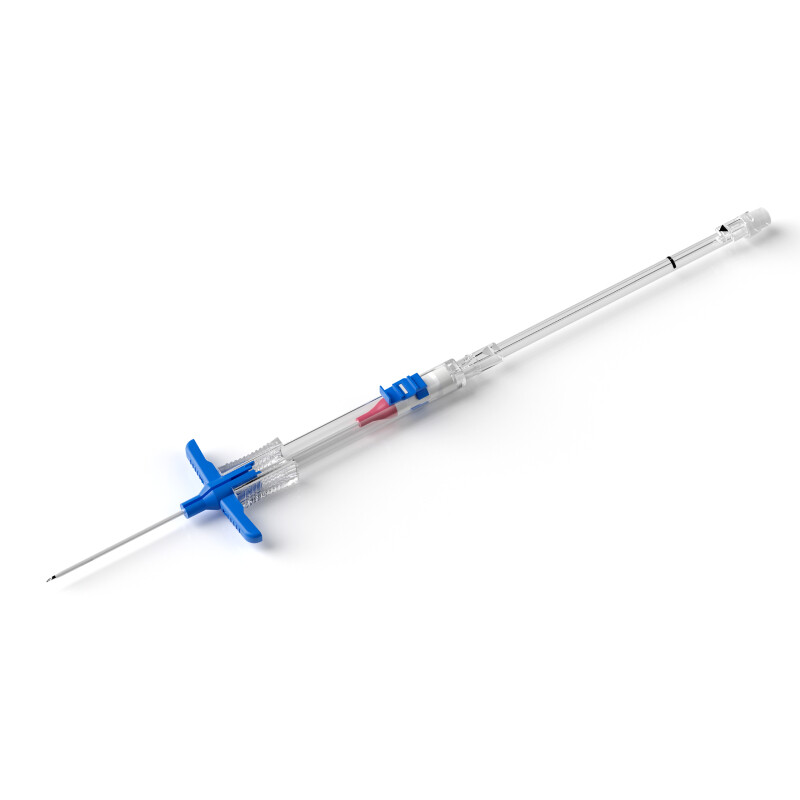Excerpts from <Status Research and Prospect of Mini Midline>
Papers sharing from Faculty of Medicine, Yangtze University and Cancer Center of Hubei Provincial People's Hospital
Mini-midline [1-2] is an external intravenous infusion device between short catheters (SC) (length <6 cm) and midline catheters (MC) (length 15 to 30 cm), usually placed in the shallow vein of the forearm with conventional puncture techniques, or placed in the deep vein of the middle of the upper arm with ultrasound guidance technique, the tip should not exceed the armpit, and is 6 to 15 cm long. The sizes of Mini Midline range from 3F to 5 F, generally indwelling time from 1 to 4 weeks [3] . The flow rate of the catheter is determined by the catheter size and length, the most common in China is 8cm (20 G or 22 G) and 10 cm (18 G) 2 types, the catheter is made of polyurethane material. Scholars such us Fabiani [4] said that the economic cost of mini midline catheters is 1/6 times that of Midline catheters.However due to the large gap between domestic and foreign countries in terms of catheterization and maintenance costs, meantime, there is a lack of high-quality research in China to confirm the validity and credibility of this conclusion, and further research and exploration are needed in the future. Mini midline catheters have certain advantages over other catheters in terms of temporality (catheterization time and indwelling time), economy (catheterization costs and maintenance costs), and practical safety (complications) of integrated intravenous infusion devices. The research and application of mini midline in China is still in the initial stage of exploration, there are still many deficiencies in the application of mini midline, there are differences in the naming and usage of 6 to 15 cm intravenous catheters [ 5 ], the author will use the mini midline [6] as the name and will review the current status of mini midline as well as the clinical application effects, providing a reference for clinical application and further research.
Catheterization process for Mini midline
The indwelling time of catheters are affected by factors included vessels, catheters and medication [7], fully evaluation before catheterization is critical to realize the longest indwelling time and the maximum utilization of the catheter .This article reviews the catheterization process from the selection of catheterization methods, blood vessels, catheter length, medication fixation, maintenance and extubation to provide reference for clinical practice.
1.Mini midline placement method selection
The placement method of mini midline is different from that of Midline [2,8], which is catheterized under the modified seldinger technique. While mini midline is catheterized under conventional technique or guided by ultrasound. Relevant studies have shown that ultrasound-guided catheterization can reduce complications and improve the success rate of catheter placement in patients with poor vessels conditions [9]. However other relevant studies indicated that ultrasound-guided catheterization had no obvious advantage in the time of successful catheterization and the frequency of punctures. There were differences in research results [10], which need to be further discussed.
2.Selection of blood vessels
Brachial vein,basilic vein and cephalic vein can be selected for catheterization. Studies show that the incidence of phlebitis in cephalic vein is higher than that in brachial vein and basilic vein. If the patient's blood vessels allow, It is suggested to preferentially select basilic vein that can reduce the risk of brachial artery insertion and the incidence of phlebitis [7] . In addition, some studies have pointed out that doctors can also choose the leg vein with the tip below the groin, and the scalp vein with the tip above the chest in the neck as the puncture sites for pediatric patients.However due to the lack of relevant high-quality studies, the safety is still to be confirmed, and the selection of relevant veins needs to be further discussed in the future [10]. In recent years, foreign scholars have pointed out that the optimal truncation point of catheter to vein ratio (CVR) is 0.41. When the CVR < 0.41, the success rate of intubation in the first attempt is 92%. However, when the CVR >0.41, the success rate of patients' first intubation attempt was 65%(P<0.001)[11] the author believed that the catheter vessel occupation ratio could be an important reference factor when choosing different catheter diameters for patients with different vascular conditions
3.Relationship between the dwelling time and the length of mini midline
Currently, according to the nursing practice guidelines for intravenous therapy, the maximum indwelling time of catheter is 4 weeks [10]. However, studies have shown that the actual duration of catheter placement is 4-14.7 d, and the maximum indwelling time is 54 d [12]. The length of catheter is closely related to the indwelling time of catheter .Literature points out [6,13] the longer the mini-midline catheter, the longer the indwelling time of the catheter, the two are directly proportional. On the other hand, the catheter specification is selected according to the condition of the patient's blood vessels, but the indwelling time is not affected by the catheter specification, because the actual life of the catheter is affected by the catheter length, medication, intravenous treatment and other aspects [2] . The actual indwelling days of catheters vary greatly in different studies due to the occurrence of catheter complications and different causes of patient disease development. Clinically, catheters can be indwelled as needed for treatment without time limited, except in the case of early unplanned catheter removal. This strategy has proven to be safe and useful [ 14-15], can effectively reduce repeated puncture, reduce nursing workload and cost.
4.Requirements for intravenous medication of Mini midline
Studies have shown that due to the influence of the patient's own vascular conditions and drug properties and other factors, the catheter may become dysfunctional before the treatment is completed [16]. According to the standards of intravenous treatment practice guidelines [9], mini midline catheter is recommended not to be suitable for infusion of the following drugs and liquids :(1) continuous infusion of stimulant drugs,blistering agent;(2) parenteral nutrient solution;(3) liquid or drug with pH <5 or >9;(4) liquid or drug with osmotic pressure >900 mOsmL
5. Fixing and Maintenance
Evaluation is Mini midline maintenance daily routine during the indwelling time, and could not be ignored in clinical nursing practice. Effective catheter evaluation and maintenance are the prerequisite for safe and effective intravenous therapy. Dressing change frequency should be determined according to dressing type.During Mini midline indwelling time,the dressing should be replaced in time when bleeding ,dressing wetting or loosing. Chlorhexidine is recommended for skin disinfection [2,7] and iodophor may be used for allergic patients. In addition, the mini midline itself is equipped with the corresponding catheter fixator in the design for the structure of the catheter extension tube. You only need to fix and paste the fixator with its arrow at the puncture point ,and finally stick it with a transparent dressing[17].
6 . Extubation
At present, relevant guidelines at home and abroad are not clear about the optimal indwelling time of Mini midline , and the existing guidelines do not recommend routine catheter extraction according to the indwelling time of catheter regulation [18-19].If the puncture site of the catheter appears obvious discomfort such as redness, swelling, heat and pain, the catheter should be removed in time after the full evaluation of extubation indications, or catheter position is abnormal, catheter function is lost, catheter related thrombosis or catheter related infection occurs, and it is determined that the catheter is not needed for subsequent treatment, etc., to ensure the safety of patients [10-20].
[1] Paladini A, Chiaretti A, Sellasie KW, etal. Ultrasound -guided Placement of Long Peripheral Cannulas in Children over the Age of 10 Years Admitted to the Emergency Department: A Pilot Study[ J ]. BMJ Paediatr Open, 2018, 2(1): e000244.DOI:10.1136/bmjpo-2017-000244.
[2] Qin KR, Nataraja RM, Pacilli M. Long Peripheral Catheters: Is it Time to Address the Confusion?[ J ]. J Vasc Access, 2019, 20(5): 457-460.DOI:10.1177/1129729818819730.
[3] Pacilli M, Bradshaw CJ, Clarke SA. Use of 8-cm 22G-Long Peripheral Cannulas in Pediatric Patients[ J ]. J Vasc Access, 2018,19(5):496-500. DOI: 10.1177/1129729818761278.
[4] Fabiani A, Dreas L, Sanson G. Ultrasound-guided Deep-arm Veins Insertion of Long Peripheral Catheters in Patients with Difficult Venous Access after Cardiac Surgery[ J ].Heart Lung, 2017, 46(1):46-53.DOI:10.1016/j.hrtlng.2016.09.003.
[5] Qin K R, Pittiruti M, Nataraja RM, et al. Long Peripheral Catheters and Midline Catheters: Insights from a Survey of Vascular Access Specialists[ J ]. J Vasc Access, 2020, 11297 29820966226.DOI: 10.1177/1129729820966226.
[6] Brugioni L, Bertellini E, Ravazzini M, et al. Guide-wire Replacement of a Mini-midline Catheter with a Central Venous Catheter: A Retrospective Study on 63 Cases[ J ]. J Vasc Access,2020, 1129729820944066.DOI:10.1177/1129729820944066.
[7] Bahl A, Hijazi M, Chen NW, et al. Ultralong Versus Standard Long Peripheral Intravenous Catheters: A Randomized Controlled Trial of Ultrasonographically Guided Catheter Survival[ J ]. Ann Emerg Med, 2020, 76(2): 134-142.DOI:10.1016/j.annemergmed.2019.11.013.
[8] Gilardi E, Giannuzzi R, Woldesellasie K, et al. Mini-midline in Difficult Intravenous Access Patients in Emergency Department: A Prospective Analysis[ J ]. J Vasc Access, 2020, 21(4): 449-455.DOI:10.1177/1129729819883129.
[9] Gorski LA, Hadaway L, Hagle ME, et al. Infusion Therapy Standards of Practice, 8th Edition[ J ]. J Infus Nurs,2021,44 (1S Suppl 1):S1-S224.DOI:10.1097/NAN.0000000000000396.
[10] Song Lei, Wei Lili, Jiang Wenbin, et al. Long catheter placement with ultrasound guidance reduces the incidence of catheter-associated bloodstream infection [J]. Chinese Journal of Emergency Medicine 2021,
30 (4):407 -413. DOI:10.3760/cma.j.issn.1671 -0282.2021.04.006.
[11] Van Loon FHJ, Korsten HHM, Dierick-van Daele ATM,etal. The Impact of the Catheter to Vein Ratio on Peripheral Intravenous Cannulation Success, a Post-hoc Analyses[ J ]. PLoS One, 2021,24,16(5):e0252166. DOI: 10.1371/journal. pone.0252166.
[12] Fabiani A,Eletto V,Dreas L,et al.Midline or Long Peripheral Catheters in Difficult Venous Access Conditions? A Comparative Study in Patients with Acute Cardiovascular Diseases[ J ]. Am J Infect Control, 2020, 48(10):1158 -1165. DOI:10.1016/j.ajic.2019.12.025.
[13] Pavelkova K, Lisova K, Blahova P, et al. Comparison of 12-cm Versus 6-cm Long Peripheral Catheters in Patients with Difficult Intravenous Access (DIVA)[ J ]. J Vasc Access, 2020, 1129729820983151. DOI:10.1177/1129729820 983151.
[14] Webster J, Osborne S, Rickard CM, et al. Clinically-indicated Replacement Versus Routine Replacement of Peripheral Venous Catheters[ J ]. Cochrane Database Syst Rev, 2019,1(1):CD007798.DOI:10.1002/14651858.CD007798.pub5.
[15] Morrison K, Holt KE. The Effectiveness of Clinically Indicated Replacement of Peripheral Intravenous Catheters: An Evidence Review with Implications for Clinical Practice[ J ]. Worldviews Evid Based Nurs,2015,12(4):187-198. DOI:10. 1111/wvn.12102.
[16] Hackett A, Wells C, Zhang Z, et al. Development of a Peripheral Intravenous Access Training Program for Nurses in the Pediatric Intensive Care Units[ J ]. J Pediatr Nurs, 2021,
61:394-403. DOI:10.1016/j.pedn.2021.09.017.
[17] Marsh N, Webster J, Mihala G, et al. Devices and Dressings to Secure Peripheral Venous Catheters to Prevent Complications[ J ]. Cochrane Database Syst Rev, 2015,(6): CD011070. DOI:10.1002/14651858.CD011070.pub2.
[18] Gorski LA. The 2016 Infusion Therapy Standards of Practice[ J ]. Home Healthc Now, 2017, 35(1):10 -18.DOI:10. 1097/NHH.0000000000000481.
[19] Lyman GH, Bohlke K, Khorana AA, et al, Venous Throm boembolism Prophylaxis and Treatment in Patients with Cancer: American Society of Clinical Oncology Clinical Pra

